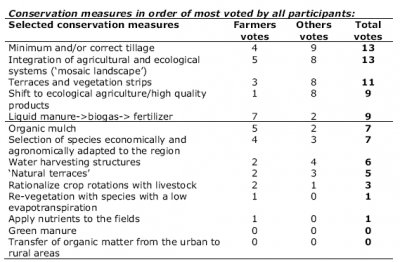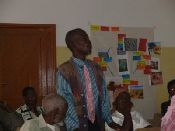|
Identifying strategies: Stakeholder Workshop 1 |
 |
|
The first DESIRE stakeholder workshop on conservation measures in the Guadalentin drainage basin, held the 21 February 2008 in the village of Totana.
|
The workshop objectives were:
1. Mutual learning
2. Identification of relevant land degradation problems in the Guadalentin
3. Identification of existing and new soil conservation strategies
4. Selection of 3-5 promising solutions for land degradation for further evaluation and study after the workshop
|
Potential solutions as identified by stakeholders
|





|
1. Minimum and/or correct tillage.
2. Controlled urbanisation.
3. Mulching with organic or non-organic material
4. Green manure.
5. Selection of species economically and agronomically adapted to the region.
6. Control over the amount of water use per hectare as well as the total area with irrigated crops.
7. Re-vegetation with species with a low evapotranspiration.
8. Transfer of organic matter from the urban to rural areas
9. Collective application of measures.
10. Integration of agricultural and ecological systems ("mosaic landscape").
11. Liquid manure ->biogas-> fertilizer.
12. Payments to farmers for reducing organic matter on the forest floor.
13. Terraces and vegetation strips.
14. Water harvesting structures.
15. Apply nutrients to the fields.
16. Better law enforcement by the administration.
17. Shift to ecological agriculture/high quality products.
18. "Naturally formed graded terraces"
19. Rationalize crop rotations with livestock
|
|
Promising strategies selected by stakeholders
|
All participants were asked to vote on the 19 potential conservation measures by putting a coloured sticker above the preferred measure. Each participant was given 5 votes, except farmers who were given 8 votes. The 5 most voted measures were selected.
As farmers voted in a different colour, separate lists were made to highlight the differences in priorities between farmers and other stakeholders.
|

|
Resulting overall strategy
 |
The resulting overall strategy, based on the evaluation and selection of promising strategies.
|
Main conclusions: strengths and weaknesses
- All participants seem convinced about the need to maintain soil as a valuable resource, although it is not evident if it is their priority.
- The farmers are open to apply conservation measures on their fields, but need economic help from the administration.
- Farmers stress the fact that close collaboration through agricultural cooperatives is required to apply conservation measures.
- All farmers also agree that it is fundamental to develop a strategy at regional level, since application of most measures at the individual or farm level is considered useless.
- There seems to be some disagreement on the kind of conservation measures proposed by the administration (regional and EU) and those that are considered feasible by the farmers.
- All participants agree that an important unfavourable factor for soil conservation and sustainable development is the absence of young people with interest in farming and the loss of traditional knowledge on soil and water conservation in agricultural landscapes.
- Of the five most voted conservation measures, two were highly valued by both farmers and other stakeholders: "minimum/correct tillage" and "the integration of ecological and agricultural systems".
|












